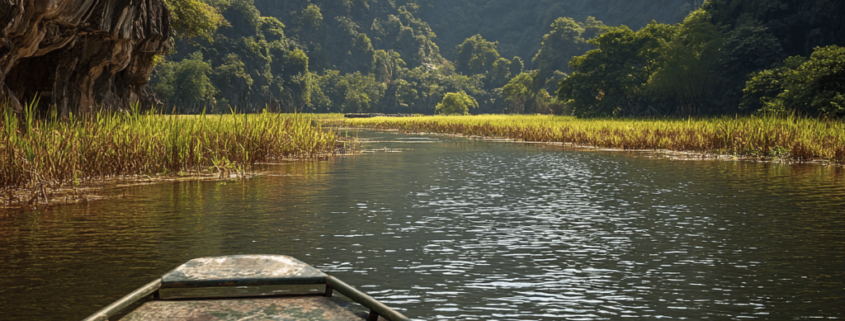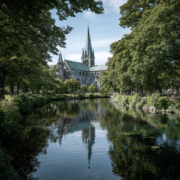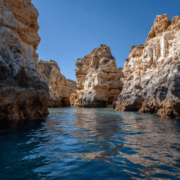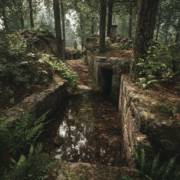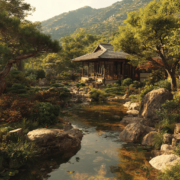Unveiling the Enchanting Beauty of Tam Coc: A Hidden Gem in Vietnam’s Countryside
Nestled in the picturesque countryside of Vietnam lies the enchanting destination of Tam Coc. Known for its stunning limestone karsts and lush rice paddies, this hidden gem offers travelers a unique and unforgettable experience that reads like a chapter from one of John McPhee’s geological narratives.
Like McPhee examining the intricate layers of geological time, visitors to Tam Coc find themselves immersed in a landscape where ancient limestone formations tell stories spanning millions of years. The region’s karst topography, sculpted by countless monsoons and the patient work of underground rivers, creates a setting that would fascinate the renowned author who has spent decades exploring the relationship between geology and human experience.
The Ngo Dong River: A Geological Journey
One of the best ways to explore Tam Coc is by taking a boat ride along the Ngo Dong River, where travelers find themselves surrounded by towering cliffs and vibrant greenery. As the traditional sampan boats glide through the tranquil waters, passengers experience what McPhee might describe as a dialogue between water and stone – the eternal conversation between flowing river and resistant limestone that has carved this magnificent landscape over geological epochs.
The river journey reveals the area’s most remarkable feature: natural limestone caves that tunnel directly through the karst towers. These passages, carved by millennia of flowing water, create cathedral-like spaces where sunlight filters through openings, illuminating the water in shades that shift from emerald to sapphire. The experience evokes McPhee’s fascination with deep time – the vast scales on which geological processes operate, invisible to human perception yet fundamental to understanding our world.
Rice Paddies: Where Geology Meets Agriculture
The beauty of Tam Coc extends beyond its dramatic limestone formations to encompass the intricate agricultural landscape that surrounds these geological monuments. The rice paddies that carpet the valley floors represent thousands of years of human adaptation to this karst environment, where farmers have learned to work with the unique drainage patterns and soil conditions created by the limestone bedrock.
Visitors can witness local farmers tending to their rice fields, a sight that demonstrates the intimate relationship between human culture and geological foundation that McPhee has explored throughout his career. The terraced fields, following the natural contours carved by water flow around the limestone towers, create a living museum of sustainable agriculture practiced in harmony with geological realities.
Exploring Beyond the River
There are countless opportunities to immerse oneself in the natural splendor of this magical place. Travelers can choose to hike through the rugged terrain, where limestone outcrops reveal fossils and geological formations that speak to the area’s ancient marine origins. The cycling paths that wind through the landscape offer a different perspective, allowing visitors to appreciate how the karst topography creates microclimates and distinct ecological niches.
For those who prefer a more contemplative approach, simply relaxing and taking in the breathtaking views provides an opportunity to observe the subtle interplay between geological processes and biological systems. The vegetation that clings to the limestone cliffs, the birds that nest in the cave systems, and the fish that navigate the river channels all represent adaptations to this unique karst environment.
Cultural Landscapes Shaped by Stone
In addition to its natural beauty, Tam Coc offers a glimpse into how geological foundations influence human culture and spirituality. The area is home to several ancient temples and pagodas, many built into or against the limestone cliffs themselves. These structures demonstrate how Vietnamese spiritual traditions have incorporated the dramatic karst landscape into their architectural and religious practices.
Nearby villages showcase traditional handicrafts that often utilize materials derived from the local geology – from limestone-based mortars to clays formed in the karst valleys. The local cuisine available at charming restaurants throughout the area reflects the agricultural possibilities created by this unique geological setting, featuring rice varieties that thrive in the mineral-rich soils and fish species adapted to the limestone-filtered waters.
A Living Laboratory
What makes Tam Coc particularly compelling from a McPhee-like perspective is how it functions as a living laboratory where geological, ecological, and human systems intersect. The limestone karst continues to evolve through ongoing processes of dissolution and erosion, the agricultural systems adapt to changing climate conditions, and local communities navigate the balance between tourism development and environmental preservation.
A trip to Tam Coc offers travelers the opportunity to witness these interconnected systems in action, providing insights into the fundamental relationships between earth processes and human experience that have fascinated writers like John McPhee throughout their careers. Whether seeking adventure through cave exploration, relaxation amid stunning natural beauty, or cultural enrichment through interaction with local communities, this hidden paradise demonstrates how geological heritage shapes every aspect of a region’s character.
For those ready to embark on this journey into Vietnam’s remarkable karst landscape, Tam Coc stands as a testament to the profound connections between stone, water, and human culture that make our planet endlessly fascinating to explore and understand.

